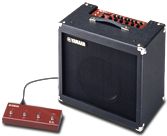Distortion
As musicians began cranking up the volume,
amplifiers started clipping and distorting the sound. Most bass
and keyboard players found this undesirable, but guitarists liked
the sound distortions. Manufacturers then looked for
ways to make their amps reliably distort the guitar's sound.
Most guitar amps feature distortion as an option by
offering two volume controls -- the Pre or Gain Control, and the
Post or Master Volume Control. The Gain
control determines the output volume of the preamp. The Master
Volume control of the power amp determines the overall
output of the amplified signal. By turning the Gain control to a
higher level than the Master Volume, the signal becomes
"overdriven." This results in the desired distorted
sound, but at less than eardrum-breaking volume. Switchable
Channels
Many guitar amps feature two channels, one for crystal
clear "clean" sound (labeled Clean) and one for "distorted" or "dirty" sound (labeled
Overdrive, Lead, Crunch,
Ultra etc). You can go from the clean to the distortion channel with the push of a button on the
control panel, or on some amps, with a footswitch on the floor. There are
separate controls for each channel:
Clean channel -- use Volume (sometimes labeled Level) to adjust the overall volume of the clean
sound.
Distortion channel -- use Gain (sometimes
labeled Pre Gain) to adjust the amount of distortion, and Volume
(sometimes labeled Post Gain, Level) to adjust the output volume
of the distorted sound. Equalization or EQ
This is a tone control technique designed to shape sound. It is used to
boost specific frequencies, or to remove (cut) or de-emphasize
unwanted frequencies. The EQ can be adjusted on most amps with the
bass, middle, and treble controls (sometimes labeled low, mid,
high) that work pretty much like those of your home stereo. The
bass controls the low frequencies and the treble controls the
high frequencies. More expensive two-channel amps may have
separate EQ controls for each channel. Some amps offer a Graphic EQ
which is a set of slider controls like you find on a home
stereo. This gives you improved creative control over the
overall balance between different frequencies your instrument
produces. Reverb
Many amps feature a reverb sound effect to complement
the switchable distortion. Reverb is a nice option to have. It adds richness to your instrument,
giving an "I'm in an empty auditorium" sound. If your amp doesn't have reverb, you can buy
a reverb effects pedal that will do the job. |

Controls for an amp with two
switchable channels: Clean
and Overdrive (Distortion).

Controls for an amp with two
foot-switchable channels:
Clean and Lead (Distortion).
This amp has separate
EQ controls (Low, Mid, High)
for
each channel.
view
large image of
entire control panel

Amp with a footswitch

Use the reverb control knob
to dial in the amount of
reverb that you
hear, from
none to full saturation.
|
|
